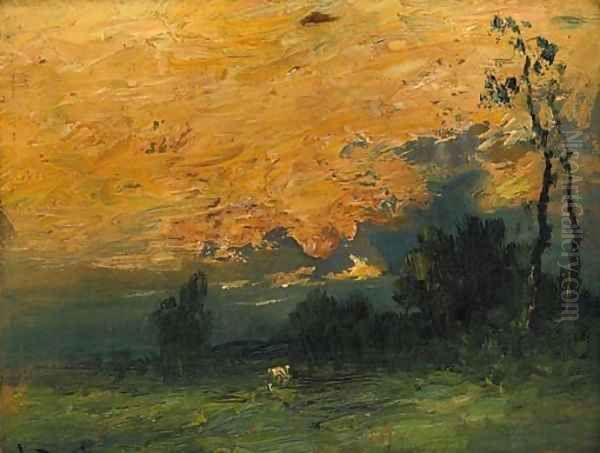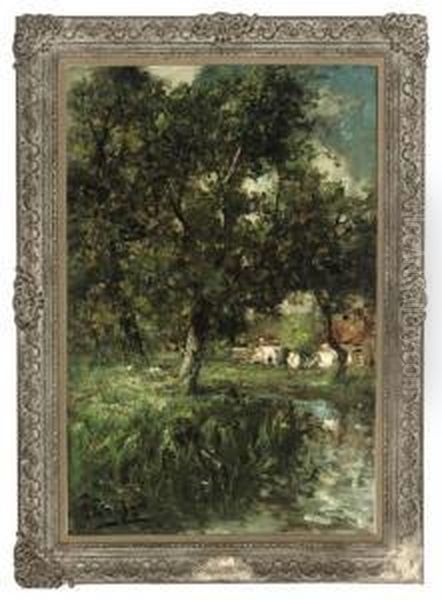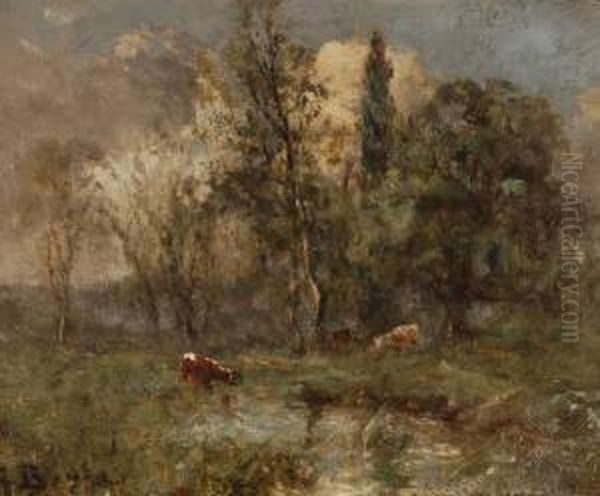George Boyle (1842-1930) was a British painter who navigated the evolving artistic landscapes of the late 19th and early 20th centuries. While perhaps not as widely celebrated today as some of his contemporaries, Boyle made a distinctive contribution to British art, particularly through his engagement with Impressionistic techniques and his focus on landscape and coastal scenes. His work reflects the broader trends of artists seeking new ways to capture light, atmosphere, and the fleeting moments of nature, moving away from the more rigid academic traditions that had long dominated British art.
The Artistic Climate of Victorian and Edwardian Britain
To understand George Boyle's artistic journey, it's essential to consider the vibrant and often contradictory art world he inhabited. Victorian Britain was a period of immense industrial, social, and intellectual change, and its art reflected this dynamism. The Royal Academy of Arts held considerable sway, championing historical, mythological, and narrative subjects rendered with meticulous detail. Artists like Frederic Leighton, Lawrence Alma-Tadema, and Edward Poynter were titans of this establishment.
However, alongside this academic tradition, there were currents of dissent and innovation. The Pre-Raphaelite Brotherhood, though earlier in the century, had already challenged academic conventions with their emphasis on truth to nature and vibrant colour. Later, the Aesthetic Movement, championed by figures like James McNeill Whistler, prioritized "art for art's sake," focusing on beauty and formal qualities over narrative content. Whistler, an American-born but London-based artist, was particularly instrumental in introducing more modern, continental ideas to the British art scene, including an appreciation for Japanese art and a more tonal, atmospheric approach to painting.
By the time Boyle was establishing his career, the influence of French art, particularly Impressionism, was beginning to be felt more strongly in Britain. While initially met with skepticism by conservative critics, the revolutionary approach of painters like Claude Monet, Camille Pissarro, and Alfred Sisley, with their emphasis on capturing the transient effects of light and colour through broken brushwork and en plein air (outdoor) painting, gradually found adherents and admirers across the Channel.
The Allure of the Barbizon School and Early Influences

The information provided suggests that George Boyle was influenced by the French Barbizon School. This group of painters, active from roughly the 1830s to the 1870s, congregated in and around the village of Barbizon near the Forest of Fontainebleau. They were pivotal in establishing landscape painting as a significant genre in its own right, rather than merely a backdrop for historical or mythological scenes.
Key figures of the Barbizon School included Jean-Baptiste-Camille Corot, renowned for his soft, lyrical landscapes and silvery light; Jean-François Millet, famous for his dignified portrayals of peasant life and rural labour; Théodore Rousseau, a meticulous observer of nature and a leader of the movement; and Charles-François Daubigny, who often painted from a specially equipped studio boat to capture waterside scenes directly. Other notable members were Constant Troyon, known for his animal paintings within landscapes, Narcisse Virgilio Díaz de la Peña, and Jules Dupré.
The Barbizon painters emphasized direct observation of nature, often working outdoors to capture its authentic character. They sought a more naturalistic and less idealized representation of the landscape than was common in academic art. Their work often possessed a quiet, contemplative mood, and they were masters at conveying the atmosphere and specific light conditions of a scene. For a British artist like Boyle, the Barbizon School's commitment to naturalism and their focus on the humble beauty of the countryside would have offered a compelling alternative to the grand narratives often favoured by the Royal Academy. This influence likely shaped his approach to composition, his choice of subject matter, and his desire to capture the essence of the British landscape.
Embracing Impressionism: A British Perspective
While the Barbizon School provided a foundation in naturalistic landscape, Boyle is also identified as an Impressionist painter, specifically working within a post-Impressionist framework. British Impressionism, sometimes referred to as English Impressionism, developed somewhat later than its French counterpart and had its own distinct characteristics. Artists in Britain were often more moderate in their application of Impressionist techniques, sometimes blending them with more traditional approaches to drawing and composition.

The New English Art Club (NEAC), founded in 1886, became a key venue for artists who were dissatisfied with the conservatism of the Royal Academy and were open to French influences. Figures like Philip Wilson Steer and Walter Sickert were prominent members and leading exponents of British Impressionism. Steer, for instance, created wonderfully atmospheric beach scenes and landscapes that clearly showed the influence of Monet and Whistler. Sickert, while also influenced by Degas, developed a more urban and psychologically charged form of Impressionism.
Other artists who contributed to the Impressionist current in Britain included Stanhope Forbes and Frank Bramley of the Newlyn School in Cornwall, who applied Impressionist principles to scenes of rural and fishing life, often with a strong social realist element. George Clausen was another significant figure who depicted rural life with an understanding of light and atmosphere derived from French naturalism and Impressionism. The Glasgow Boys, a group of Scottish painters including James Guthrie and John Lavery, also embraced en plein air painting and Impressionistic techniques, bringing a fresh vitality to Scottish art.
For George Boyle, working within this milieu meant engaging with the challenge of rendering the specific qualities of British light and landscape – often more muted and diffuse than the bright sunshine of southern France – using techniques pioneered by the French Impressionists. This would involve a focus on capturing fleeting moments, the play of light on surfaces, and the overall atmosphere of a scene, likely using a brighter palette and more visible brushstrokes than traditional academic painting.
Boyle's Artistic Vision: Light, Landscape, and Atmosphere
As a landscape and seascape painter, George Boyle's primary concern would have been the depiction of the natural world. His preference for these subjects aligns perfectly with the core tenets of both the Barbizon School and Impressionism. The British countryside, with its varied terrains, changing weather patterns, and distinctive coastal areas, offered a rich source of inspiration.
His style, described as post-Impressionist, suggests that while he adopted the Impressionist concern for light and colour, he may have also incorporated later developments. Post-Impressionism is a broad term encompassing various reactions against Impressionism, often involving a greater emphasis on structure, symbolic content, or subjective expression. However, in Boyle's case, given his Barbizon influence, it's more likely that his post-Impressionism leaned towards a continued exploration of naturalistic effects, perhaps with a more structured composition or a particular emphasis on mood and atmosphere, rather than the more radical departures of artists like Van Gogh or Gauguin.

His paintings of meadows, such as "Sunset over the meadows," would have allowed him to explore the changing effects of light at different times of day, particularly the dramatic colours and long shadows of sunset. Water, a key element in works like "Cattle by a stream" and his beach scenes, is a classic Impressionist subject, offering opportunities to capture reflections, movement, and the interplay of light on its surface. The Suffolk landscape, as indicated by "At Battersford, near Stowmarket, Suffolk," is known for its gentle rolling countryside, wide skies, and picturesque villages, subjects that lent themselves well to an Impressionistic approach.
Signature Works: Glimpses into Boyle's World
The titles of George Boyle's known works provide valuable clues to his artistic preoccupations.
"Sunset over the meadows": This title immediately evokes a classic Impressionist theme. Artists like Claude Monet, with his series of haystacks and poplars, and Camille Pissarro, with his numerous depictions of rural landscapes at different times of day, frequently explored the transformative effects of sunset. Boyle's painting would likely have focused on the rich, warm colours of the sky, the long shadows cast across the fields, and the overall sense of tranquility or drama associated with the end of the day. The challenge would be to capture these fleeting effects with freshness and immediacy.
"At Battersford, near Stowmarket, Suffolk": This work points to Boyle's engagement with specific locations, a practice common among landscape painters. Suffolk, with its landscapes immortalized by earlier British masters like John Constable and Thomas Gainsborough, has a rich artistic heritage. Boyle, working in a later era, would have brought an Impressionist sensibility to these scenes, focusing on light, atmosphere, and the everyday charm of the English countryside. The painting likely depicted a characteristic Suffolk view, perhaps featuring a river, a village, or agricultural land, rendered with attention to the particular light and weather conditions of the region.
"Cattle by a stream": This subject combines pastoral elements with the dynamic qualities of water. Cattle in landscapes were a popular motif in 19th-century art, seen in the works of Barbizon painters like Constant Troyon and British artists like Thomas Sidney Cooper. For an Impressionist, the stream would offer opportunities to depict reflections, the sparkle of light on water, and the lush vegetation of the riverbank, while the cattle would add a sense of life and rural character to the scene.
While specific details about the execution of these paintings (such as precise dates of creation or dimensions beyond what is generally known from auction records) are not readily available in the provided summary, the titles themselves suggest a body of work dedicated to capturing the beauty and atmosphere of the British landscape through an Impressionist lens.
Exhibiting and Navigating the Art World
For an artist like George Boyle, active in the late 19th and early 20th centuries, exhibiting his work would have been crucial for gaining recognition and sales. While the Royal Academy remained the most prestigious venue, alternative exhibition societies played an increasingly important role for artists with more modern tendencies.
The New English Art Club, as mentioned, was a key outlet. Other possibilities included the Royal Society of British Artists (RBA), which under Whistler's presidency in the 1880s briefly became a more progressive forum, or the Grosvenor Gallery and later the New Gallery, which were known for showcasing Aesthetic Movement and avant-garde art. Smaller commercial galleries in London were also growing in importance, providing artists with opportunities for solo or group shows.
Participation in these exhibitions would have allowed Boyle to present his work to the public and critics, and to engage with the ongoing debates about the direction of modern art. The appearance of his works at auction in more recent times indicates that his paintings have retained a presence in the art market, appreciated by collectors of British Impressionist and landscape art.
Contemporaries and the Broader British Art Scene
George Boyle worked during a period rich with artistic talent in Britain. Beyond the key Impressionist figures already mentioned, the art scene was diverse. The late Victorian and Edwardian eras saw the flourishing of artists like John Singer Sargent, an American expatriate whose dazzling portraits and vibrant watercolour landscapes displayed a virtuosic technique and a keen sense of light. His work, while not strictly Impressionist, shared a similar freshness and immediacy.
The Arts and Crafts Movement, led by figures like William Morris, also had a profound impact, emphasizing craftsmanship and design, and often drawing inspiration from nature. While primarily focused on decorative arts, its aesthetic principles influenced painters as well.
The period also saw the rise of narrative painting with a social conscience, and the continuation of strong traditions in watercolour painting, a medium in which British artists had long excelled. Artists like Hercules Brabazon Brabazon, for example, created wonderfully evocative and loosely handled watercolours that captured the essence of landscapes with an almost abstract quality, prefiguring later developments.
Boyle's focus on landscape and his Impressionistic style placed him within a significant current of British art that sought to capture the national scenery with a modern sensibility. He would have been aware of, and likely interacted with, many of these diverse artistic trends and personalities that shaped the cultural landscape of his time.
The Enduring Appeal of Impressionist Landscapes
The Impressionist approach to landscape painting, with its emphasis on light, colour, and atmosphere, continues to resonate with audiences today. The ability of these artists to capture a fleeting moment, the feeling of being present in a particular place at a particular time, gives their work an enduring freshness and appeal.
George Boyle's contribution to this tradition lies in his application of these principles to the British landscape. His paintings offer a vision of meadows, streams, and coastal scenes filtered through an Impressionist sensibility, inviting viewers to appreciate the subtle beauties of the natural world. While he may not have achieved the same level of fame as some of the leading French or even British Impressionists, his work forms part of the rich tapestry of late 19th and early 20th-century British art.
Legacy and Rediscovery
The careers of many competent and talented artists from past eras often await fuller rediscovery. George Boyle, as a British Impressionist and landscape painter influenced by the Barbizon School, represents a significant strand of artistic practice in his time. His works, such as "Sunset over the meadows," "At Battersford, near Stowmarket, Suffolk," and "Cattle by a stream," provide tangible evidence of his artistic concerns and his engagement with the progressive artistic ideas of his day.
The fact that his paintings continue to appear at auctions suggests an ongoing appreciation for his skill in capturing the nuances of the British landscape and the effects of light. For art historians and enthusiasts, exploring the work of artists like George Boyle helps to build a more complete and nuanced understanding of the period, revealing the depth and breadth of artistic talent that flourished beyond the most famous names. His dedication to landscape painting, informed by important European movements, marks him as a noteworthy figure in the story of British art.
Conclusion
George Boyle (1842-1930) stands as an interesting example of a British artist who absorbed and adapted the revolutionary ideas of the Barbizon School and Impressionism to depict his native landscape. His focus on light, atmosphere, and the everyday beauty of nature places him firmly within the lineage of modern landscape painting. While further research might unearth more details about his life and career, his known works and the artistic context in which he operated allow us to appreciate his contribution as a dedicated painter of the British scene, whose art offers a gentle yet perceptive vision of the world around him. His paintings serve as a quiet reminder of the enduring power of landscape to inspire artists and to connect with viewers across generations.